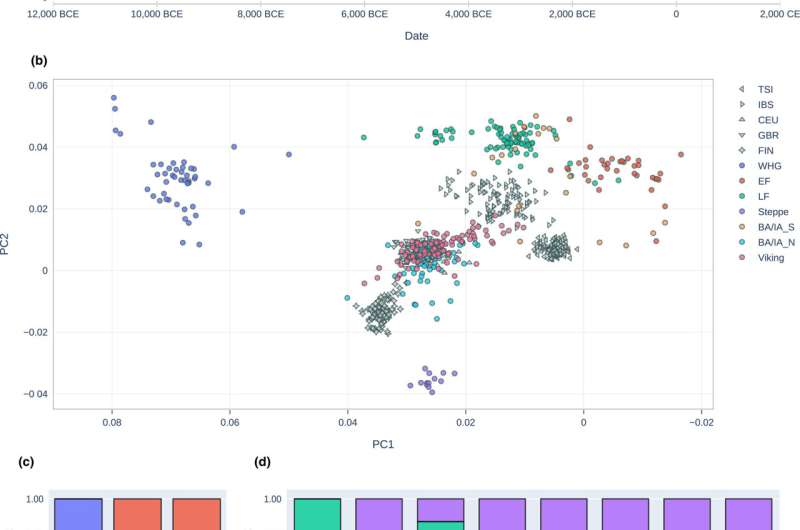This article has been reviewed according to Science X's editorial process and policies. Editors have highlighted the following attributes while ensuring the content's credibility:
fact-checked
peer-reviewed publication
proofread
Genetic contribution from the Stone Age may influence our chance to have a long life

Our lifestyle has a very big influence on our life expectancy, such as our level of fitness, or whether we smoke or are overweight. Other external factors like social contacts, environmental conditions or education are also important. In addition, our genes also help determine how long we may live. Longevity in humans means living to 95 years and older in relatively good health.
"Variations in the APOE gene have the highest genetic contribution to longevity," says Professor Almut Nebel from the Institute of Clinical Molecular Biology (IKMB) at Kiel University (CAU).
The APOE gene provides the blueprint for apolipoprotein E (APOE), which plays an important role in lipid metabolism as a component of lipoproteins.
The three variants ε2, ε3 and ε4 are relevant for longevity. APOE ε4 is associated with a very high risk of Alzheimer's disease and can consequently shorten life expectancy. APOE ε2, on the other hand, increases the chance of living a long life, and ε3 is considered neutral. In Europe, the three variants are distributed quite unevenly, with the frequency of the unfavorable variant ε4 decreasing from the north (22%) towards the south (6%).
The ε2 and ε3 frequencies also vary widely geographically, with ε3 usually being the most common (at least 70%) and ε2 the rarest variant in a population (at most 12%). A research team led by Professor Nebel was the first to use paleogenetics to investigate what may have led to this distribution. They recently published their results in the journal Aging Cell.
"We were able to show that the current distribution of variants in Europe arose primarily from two major immigrations 7,500 years ago and 4,800 years ago, and the subsequent mixing of population groups," reports first author Daniel Kolbe from Nebel's research group. "The differences between northern and southern Europe can mainly be explained by these two demographic processes," says Kolbe, who is doing his Ph.D. in the Translational Evolutionary Research (TransEvo) research training group (GRK) at the CAU.
This finding is completely new. So far, the different frequencies of the three gene variants have mainly been attributed to natural selection. This assumption was based on genetic data from people living today.
"In our work, we included DNA sequences from archaeologically well-dated skeletons. These allow us to travel back in time and thus directly explore the possible influence of events in the past," says Kolbe. The investigation included over 358 datasets from bone samples which are up to 12,000 years old. These were used to calculate the frequencies of APOE variants in various prehistoric and medieval populations in Europe.
Surprisingly, according to Kolbe, the mobile hunter-gatherers of the Stone Age had a high frequency of the ε4 variant (about 40%), which from today's perspective is considered harmful, while ε2 was not detectable. The first sedentary farmers, on the other hand, had a very low ε4 frequency (about 4%) and a high ε3 frequency (about 91%). "These differences probably arose as adaptations to the specific diets and lifestyles of the two groups," Kolbe says.
We know from modern studies that physical activity can reduce the risk of Alzheimer's disease for ε4 carriers. "We will likely never know whether the hunter-gatherers suffered from Alzheimer's or how ε4 may have been involved. But it is possible that they quite literally outran or escaped the bad variant, since they periodically covered long distances on foot," Kolbe explains.
"Our study thus supports the recommendation that an active lifestyle pays off, especially for the approximately 15 percent of Germans who have the ε4 variant." In contrast, ε2 and ε3 seem to have represented an advantage for the first farming people. APOE ε2 may have contributed to better digestion of high-starch diets, which were often on the menu of farmers. APOE ε3 in turn probably favored the storage of calories in the form of fat as a reserve for hard times.
These specific adaptations are probably not related to longevity, which may well be a modern phenomenon.
This study underpins how important evolutionary biology research approaches are for many challenges of the modern era. "Our results show how an unfavorable genetic predisposition can be compensated for by an adapted lifestyle, which in this case is particularly relevant for the aging population of today," explains last author Nebel, who has long been researching the molecular basis of longevity.
More information: Daniel Kolbe et al, Current allele distribution of the human longevity gene APOE in Europe can mainly be explained by ancient admixture, Aging Cell (2023). DOI: 10.1111/acel.13819
Journal information: Aging Cell
Provided by Christian-Albrechts-Universität zu Kiel





















